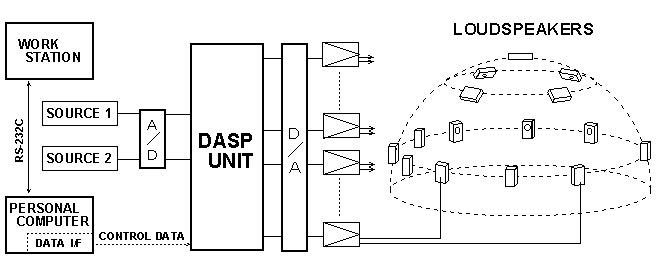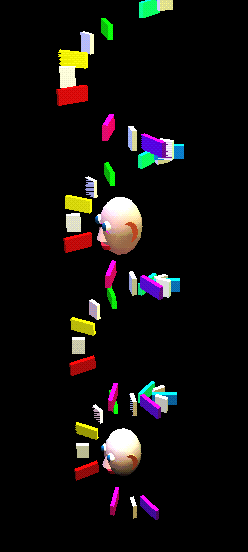
Katsumi Amano,
Fumio Matsushita,
and
Hirofumi Yanagawa
Pioneer Electronic Corp.
2610 Hanazono 4-chome, Tokorozawa-shi; Saitama 359
voice: (0429)42-1151; fax: (0429)43-0395
{ama,
mat,
yana}@asd.pioneer.co.jp
Michael Cohen
and
Jens Herder
University of Aizu 965-80
voice: (0242)37-2537;
fax: (0242)37-2549
{mcohen,
herder}@u-aizu.ac.jp
Yoshiharu Koba
and
Mikio Tohyama
Kogakuin University
5-601 Dept. of Electronic Engineeering;
2665-1 Nagano-machi; Hachioji-shi, Tokyo 192
voice: (0246)25-8982; fax: (0426)25-8982
{koba@yamato,
ctdeneuv@sin}.cc.kogakuin.ac.jp
The PSFC, or Pioneer Sound Field Control System, is a DSP-driven hemispherical 14-loudspeaker array, installed at the University of Aizu Multimedia Center. Collocated with a large screen rear-projection stereographic display, the PSFC features realtime control of virtual room characteristics and direction of two separate sound sources, smoothly steering them around a configurable soundscape. The PSFC controls an entire sound field, including sound direction, virtual distance, and simulated environment (reverb level, room size and liveness) for each source. It can also configure a dry (DSP-less) switching matrix for direct directionalization. The PSFC speaker dome is about 14m in diameter, allowing about 20 users at once to comfortably stand or sit near its sweet spot.

As a spatially immersive display, the large (3m x 9m) screen and speaker array combination crosses the intimacy of traditional HMD-style with the freedom of so-called "desktop VR" systems, allowing multiple users to share perspective. With such a speaker array, soundscape stabalization is natural (and no head-tracking is needed).
| display | ||
|---|---|---|
| intimacy | audio | visual |
| personal | headphones | HMD |
| nearphones | desktop monitor | |
| transaural speakers | HDTV | |
| multipersonal or social (spatially immersive displays) | speaker array | large-screen display |
| public | public address | |

This interface configures both the presence (virtual room environment) and the source characteristics of the sound field. Ambience is set by combination (level and timing) of direct sound, discrete early reflections, and late diffuse reverberation. Direction is set by programming azimuth and elevation for two independent sources, which can move around with update of 100ms. Early reflection patterns, calculated via an image source model, are dynamically selected according to direction, while the reverberation patterns are exponentially decayed noise filters, independent of source position. Room liveness scales the reflection and reverberation tap amplitudes; a setting of 0 corresponds to a free-field or anechoic condition. Room size is set by programming delay for reflection (0-500ms). Reflection patterns can be chosen from one of twenty presets; overall volume is controlled by level. The ratio of direct:reverberant energy is a cue to source distance. For example, low gain and high liveness suggest a distant source, while high gain and low liveness suggest a close source. A pass-through mode configures null DSP with a switching matrix function.
For example,
inspired by the cyclical nature of octaves and helical structure of a
scale, we prepared a model of a piano-style keyboard
which was then geometrically warped into a left-handed
helical configuration, one octave/revolution,
pitch mapped to height.
Our model is being imported into
(Open Inventor/)VRML, where it can be
driven by MIDI events, realtime
or sequenced, which stream is both synthesized by a sound module
and spatialized by
the PSFC,
so that the sound of the respective notes is
directionalized with respect to sinks, avatars of the human user, by
default in the tube of the helix.
|

|
 ; Copyright ©
2023, Jens Herder, All Rights Reserved.
; Copyright ©
2023, Jens Herder, All Rights Reserved.